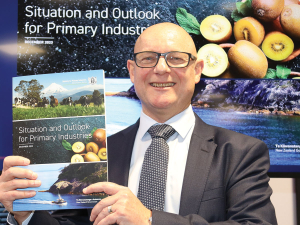MPI launches industry-wide project to manage feral deer
An industry-wide project led by Ministry for Primary Industries (MPI) is underway to deal with the rising number of feral pests, in particular, browsing pests such as deer and pigs.
 Ray Smith says red meat producers are being hit with a double whammy of increasing farm input costs and a declining demand for product.
Ray Smith says red meat producers are being hit with a double whammy of increasing farm input costs and a declining demand for product.
It's a real challenge for the country's red meat sector.
That's the word from the Director General of MPI, Ray Smith, speaking at the launch of that organisation's latest Situation and Outlook for Primary Industries (SOPI), late last year.
The Ministry for Primary Industries' report forecasts an ongoing fall in the value of lamb exports over the next two years, while beef and veal prics are forecast to drop in 2024 but pick up slightly in 2025. Overall export revenue from the meat and wool sector is forecast to decrease by 5% to $11.6 billion in the year to June 30 2024.
However, according to the SOPI report, this will be partly offset by an increase in revenue from venison and pet food.
The report adds that both farm and processor profitability are forecast to fall in 2023/24 due to lower prices and increased farm costs.
Smith told Rural News that farmers are being hit with a double whammy of increasing farm input costs and, at the same time, a declining demand for product.
"A lot will depend on when China comes back into the market as a lot of our products goes there; it is a very important markets for us," he explains. "China has been in slowdown since they came out of Covid, resulting in weak consumer demand and a bit of a lack of confidence in the market."
Smith was in China recently and met with a lot of people. He says there is a sense that if you look out 12 to 24 months ahead, we will start to see that confidence come back into that market.
China takes 38% of all NZ's meat and wool products. Breaking this figure down, 34% of our lamb goes to that market, 77% of our mutton, 43% of beef and veal and 39% of NZ's wool.
Commentary in the SOPI report says, globally, middle- and lower-income earners are expected to trade down from lamb and prime beef products to lower priced proteins - such as chicken and ground beef.
There is a bit of good news for NZ meat with higher demand in the US for manufacturing beef, used mainly in hamburgers. This trend is likely, according to the SOPI report, to limit some of the damage caused by lower prime beef prices.
Smith believes the situation in China has to some degree spilled over into other parts of Southeast Asia, but overall, the whole global economy has flattened out. On the positive side, he says there is still product getting into Europe and the US and NZ's red meat sector has a range of countries it can export to.
"But it's just in a really difficult squeeze at the moment," he says.
The other factor affecting NZ lamb exports is Australia dumping large quantities of lamb on the global market, which in turn has forced prices down. On the home front, MPI's SOPI report is predicting a high lamb crop in 2023/24 due to favourable conditions during mating and a mild winter that has led to overall higher lambing percentages.
However, there is a warning that the forecast warmer El Nino weather pattern may reduce late-season slaughter weights and there ay also be more lambs going for processing, due to dry weather and lower feed availability. The impact of this at the farmgate may drive down schedule prices.
The news on the wool front is bleak with prices forecast to soften by a further 2% in the coming year.
Our Pet Export
Apart from horticulture, one of the stars of the SOPI report was the growth of our pet meat exports. Most of NZ expors are aimed at high-end consumers and it seems these people want the best for their pets as well as themselves.
In the year to June 2023, NZ's pet food exports rose by 13%, which came on top of a 17% increase in the previous year.
The SOPI report notes that this trend is due to 'the humanisation of pets'.
The other sector to show positive growth is venison, with export prices forecast to increase 3% to $14.70 per kg in 2023/24. Again, it's the elite nature of the product that is attracting consumers in the US and China.
The National Wild Goat Hunting Competition has removed 33,418 wild goats over the past three years.
New Zealand needs a new healthcare model to address rising rates of obesity in rural communities, with the current system leaving many patients unable to access effective treatment or long-term support, warn GPs.
Southland farmers are being urged to put safety first, following a spike in tip offs about risky handling of wind-damaged trees
Third-generation Ashburton dairy farmers TJ and Mark Stewart are no strangers to adapting and evolving.
When American retail giant Cosco came to audit Open Country Dairy’s new butter plant at the Waharoa site and give the green light to supply their American stores, they allowed themselves a week for the exercise.
Fonterra chair Peter McBride says the divestment of Mainland Group is their last significant asset sale and signals the end of structural changes.

OPINION: Your old mate welcomes the proposed changes to local government but notes it drew responses that ranged from the reasonable…
OPINION: A press release from the oxygen thieves running the hot air symposium on climate change, known as COP30, grabbed your…